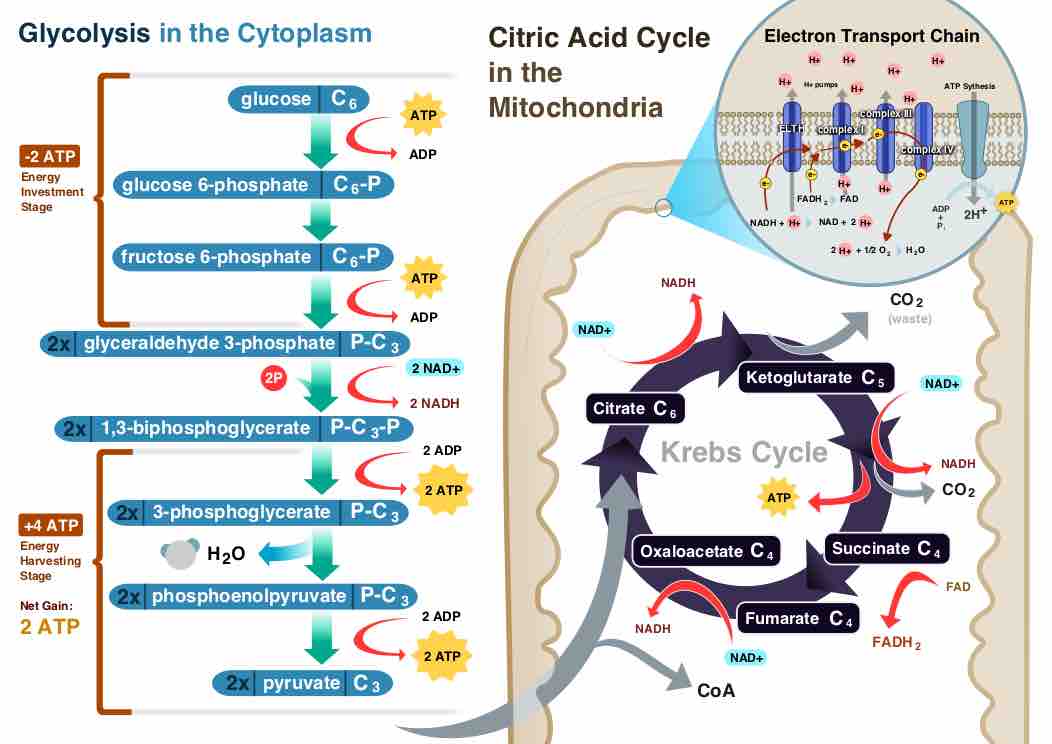Internal respiration refers to two distinct processes. The first is the exchange of gasses between the bloodstream and the tissues. The second is the process of cellular respiration, from which cells utilize oxygen to perform basic metabolic functions.
Gas Exchange with Tissues
Gas exchange occurs in the alveoli so that oxygen is loaded into the bloodstream and carbon dioxide is unloaded from the bloodstream. Afterwards, oxygen is brought to the left side of the heart via the pulmonary vein, which pumps it into systemic circulation.
Red blood cells carry the oxygen into the capillaries of the tissues of the body. Oxygen diffuses into the cells of the tissues, while carbon dioxide diffuses out of the cells of the tissues and into the bloodstream.
The factors that influence tissue gas exchange are similar to the factors of alveolar gas exchange, and include partial pressure gradients between the blood and the tissues, the blood perfusion of those tissues, and the surface areas of those tissues. Each of those factors generally increase gas exchange as those factors are increased (i.e., more oxygen diffusion in tissues with more blood perfusion).
Regarding the partial pressure gradients in systemic capillaries, they have a PaO2 of 100mmHg and a PaCO2 of 40mmHG within the capillary and a PaO2 of 40 mmHg and PaCO2 of 45 mmHg inside issue cells, which allows gas exchange to occur.
Cellular Respiration
Cellular respiration is the metabolic process by which an organism obtains energy through the reaction of oxygen with glucose to produce water, carbon dioxide and ATP, which is the functional source of energy for the cell. The oxygen supply for cellular respiration comes from the external respiration of the respiratory system.

Overview of cellular respiration
A diagram of cellular respiration including glycolysis, the Krebs cycle (also called the citric acid cycle), and the electron transport chain.
Cellular respiration includes three major steps, and occurs mainly in the cytoplasm of the cell and within the mitochondria of the cell. The net formula for cellular respiration is:
- Glycolysis: The breakdown of glucose into pyruvate, ATP, H2O, and heat.
- Krebs Cycle: Produces NADH from pyruvate.
- Oxidative Phosphorylation: Produces ATP from NADH, oxygen, and H+. The oxygen plays the role of electron receptor in an electron transport chain to produce ATP.
The net formula for cellular respiration is:
The carbon dioxide waste is the result of the carbon from glucose (C6H12O6) being broken down to produce the pyruvate and NADH intermediates needed to produce ATP at the end of respiration. The energy stored in ATP can then be used to drive processes that require energy, including biosynthesis, locomotion, or transportation of molecules across cell membranes.
Cellular respiration can occur anaerobically without oxygen, such as through lactic acid fermentation. Human cells may use lactic acid fermentation in muscle tissue during strenuous exercise when there isn't enough oxygen to power the tissues. This process is very inefficient compared to aerobic respiration, as without oxidative phosphorylation, the cell cannot produce nearly as much ATP (2 ATP compared to 38 during cellular respiration).